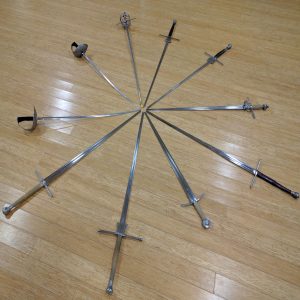I was lucky enough to get a late ticket to WMAW 2017 and spent an amazing few days in Racine, Wisconsin, learning from HEMA practitioners from all over the world.
On the last day of the event, I asked eight experienced longsword fencers to explain how they perform a parry by thrust, or absetzen.
In the sixth and final video in this series, Devon Boorman of Academie Duello and Duello.tv explains his take on the technique.
I am sincerely sorry, especially to Devon, that it took me so long to make this post. Partly I put it off because my dang head is in the video this time, not just my voice (which was bad enough) and I hate being in videos and photos. But mostly it’s because I’m the officially-recognized worst procrastinator in the galaxy. There is a gelatinous life form on an outer spiral of Andromeda who has been moving “do taxes” to tomorrow’s todo list for 8 million years & took the intergalactic title, but it’s a close competition.
See the previous posts in this series:
- Part 1: Tea Kew
- Part 2: Jess Finley
- Part 3: Jan Deneke
- Part 4: Jake Norwood
- Part 5: Ted Elsner, James Reilly, Robert Rutherfoord
One absetzen to break them all?
As I approach Devon, I know his school focuses on the Italian tradition. I am not sure he can help with this project. Maybe Devon Boorman doesn’t know what an absetzen is! Better check:
Me: Devon, does your system have the concept of a single-time parry by thrust, like an absetzen?
Robert Rutherfoord, who is standing nearby: *snort*
Me: Er. *bemused noob face*
Devon: He’s laughing because, of course I do…
Devon grins and reveals that he does, in fact, know what an absetzen is. In fact he has traveled around the world and specifically invited various fencers to do their absetzens at him and try to make one work. Many have tried. Many have failed.
Devon explains:
The point makes you powerful
Devon’s absetzen is based on manipulating the point of his sword to gain a dominant angle over the opponent’s sword and thus control the line of attack.
“If I bring the point over,” Devon explains, “I get what I call in my system the most powerful advantage of crossing, at least in the thrust; this creates a slope that forces your weapon to begin to descend to my forte.”
Long edge or short?
The question of which edge to use depends on the situation, but again, it’s all about leading with the point.
“A lot of people will roll to their false edge in a way that looks like this.” Devon demonstrates a suboptimal angle that gives me an opportunity to gain the crossing.
“If the opponent uses the point of their sword appropriately, they should overcome this… If you try to push me forward with your hands, then of course this seems like it could be strong. But as soon as they know they should pull with their back hand… (Note: I did not) then following the point is so much more powerful.”
Dealing with heavy blows
Again, the point is key. Guide the force of the blow down the slope of your sword and into your crossguard (and hence, the ground) by leading with the point.
“Even a very small or frail person – the point makes them very powerful, because they’re using the ground as support, and they’re using their skeleton to support that. ”

